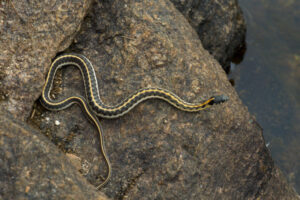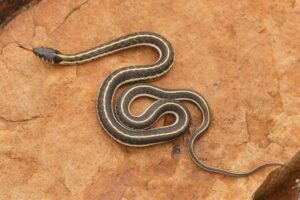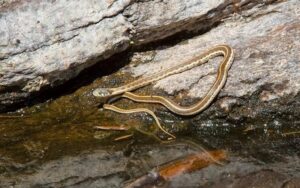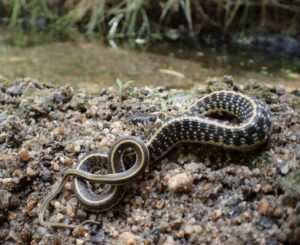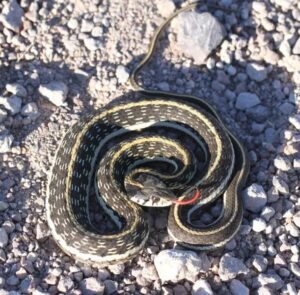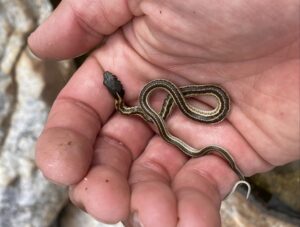The blackneck garter snake, black-necked garter snake, or black-necked gartersnake is a native of the southwestern US, Mexico, and Guatemala. The semi-aquatic colubrid is active during the day, twilight, and occasionally at night.
Scientific Classifications
- Suborder:Serpentes
- Family:Colubridae
- Genus:Thamnophis
- Species:T. cyrtopsis
Conservation Status
Subspecies
This snake has three recognized subspecies.
- Western blackneck garter snake (Thamnophis cyrtopsis cyrtopsis)
- Eastern blackneck garter snake (Thamnophis cyrtopsis ocellatus)
- Tropical black-necked garter snake (Thamnophis cyrtopsis collaris)
Description
Size
Full-grown blackneck garter snakes attain a length of 16-28 in (41-71 cm) with the maximum recorded size as 43 in (109 cm). The males are larger than the females.
Color and Appearance
The background color of the snake is dark gray to olive-gray with two cream or whitish side stripes on the 2nd and 3rd scale rows. There is also a thick, bright mid-dorsal stripe that is intensely orange or yellow in the front part of the body, creating a sharp contrast with the white stripes on the sides.
It owes its name to the paired black neck patches on either side of the dorsal stripe at the back of the bluish-gray head. Prominent black stripes outline the whitish or cream labial scales on the upper and lower jaws.
Are They Dangerous to Humans
When threatened, the colubrid first tries to escape into the surrounding cover or water. If pursued, it flattens and broadens its head to appear larger. Close threatening or capture makes it release foul-smelling excreta and anal secretions to deter its attacker. The non-venomous snake rarely uses its teeth to bite.
Blackneck Garter Snakes at a Glance
Distribution
It lives in central and southeastern Arizona, parts of the southwestern United States, Guatemala, and Mexico.
Habitat
This garter snake can be found in a wide range of habitats, frequently near water sources. It lives in grasslands, desertscrub, woodland, and chaparral environments.
Lifespan
The colubrid lives for 12-15 years in captivity. Its lifespan in the wild is unknown.
Predators
The black-necked garter snake falls prey to various vertebrates, including sunfish, bullfrogs, and other snakes.
Diet
Its diet includes amphibians, small fish, invertebrates like earthworms, and other snakes.
Reproduction
Ovoviviparous (gives birth to live young from eggs that hatch inside the body)
After hibernating from late fall to winter, the species mates in late spring or summer. The females are pregnant for a period of 3 months before giving birth to 3-24 young in a litter.
Source
wildherps.com, wildsonora.com, sabinonaturalists.org, researchgate.net, linodeobjects.com, pbs.twimg.com

